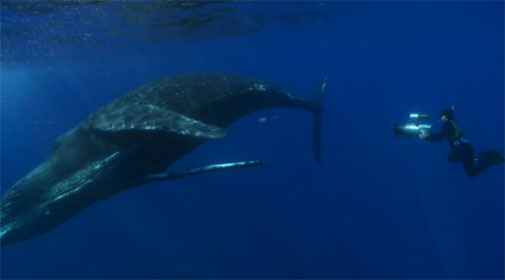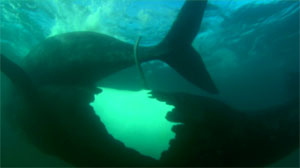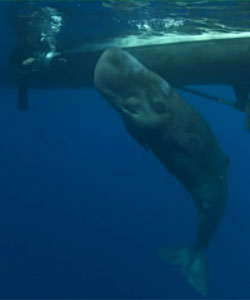
PBS surrenders its entire prime-time Wednesday lineup tonight at 8 ET to a three-hour, three-part Nature special called Ocean Giants. Originally aired on the BBC, it follows filmmakers and divers Doug Allen and Didier Noirot as they go around the world photographing, swimming with, and trying to understand the behavior of various species of whales and dolphins.
What they present, in Ocean Giants, is amazingly entertaining, and entertainingly amazing. But what I really adore is the number of times these filmmakers admit they could not film some specific behavior, or explain authoritatively why these majestic mammals do certain things.
"The truth is," admits the narrator, "nobody knows." And it's great to know that, after all this time and despite all this new technology, some of the mysteries of the deep remain just that...
Oh, but what marvels you will see in Ocean Giants.
In some sequences, the filmmakers have to dive without scuba gear, because the bubbles from oxygen tanks would be misinterpreted as aggressive underwater signals. So they hold their breath, dive in and get dangerously close to humpback whales on a courtship run.

One filmmaker, after climbing back into the boat, gushes, "That's the most amazing spectacle I have ever seen in the water." And yet the nature equivalent of the money shot -- the actual mating of a humpback whale -- has never been filmed, and isn't filmed this time, either. Humpbacks, quite clearly, cherish their privacy.
But right whales are less shy, so, as they engage in surprisingly gentle sex, you get to witness a whole new world in the realm of penis envy: a 9-foot penis, the largest in nature.
Bowhead whales and humpback whales sing intricate songs -- hum them, actually, at least in the case of the humpbacks.
Dolphins hydroplane on the beach to catch fish, play with scientist-placed bubble rings, and use intricate methods to herd and capture food.

A baby sperm whale, alone, befriends one of the photographers, until the whale's mother ascends from the deep and quickly shepherds her young away.
The perspective is what registers most here. Partly, it's the perspective provided by the camerawork, which is breathtaking. But also, it's the perspective of history, of time, and of simple reflection.
The bowhead whales, blue whales and other species can live for more than 200 years, and one bowhead was found, more than a century later, with an 1890s harpoon embedded in its gills. And when one species of whale is shown floating next to a small whale-watching boat, allowing and encouraging human embraces as well as touch, the program points out that this whale is old enough to have lived through, and recalled, the gruesomely predatory practices of the whaling era depicted in Herman Melville's Moby-Dick.
Yet here they are -- forgiving, not forgetting, and apparently getting as much as they give from the fleeting, friendly exchange with humans. Too bad they don't watch television. They're probably smart enough to enjoy Ocean Giants as well.